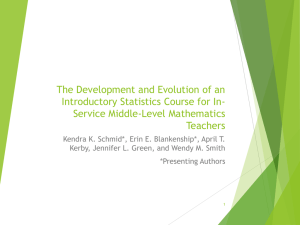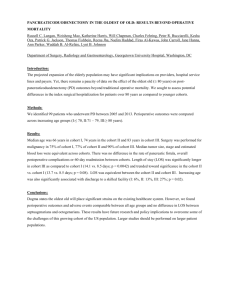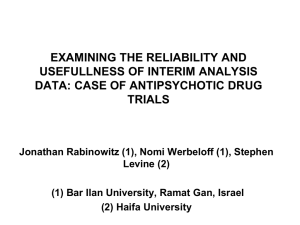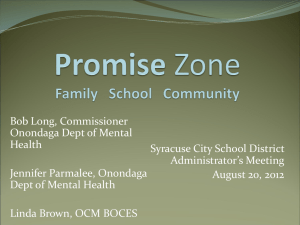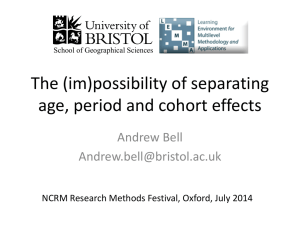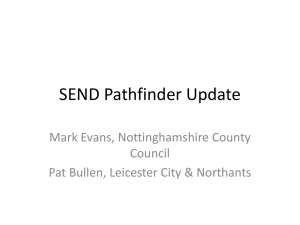Jane Elliott Centre for Longitudinal Studies
advertisement
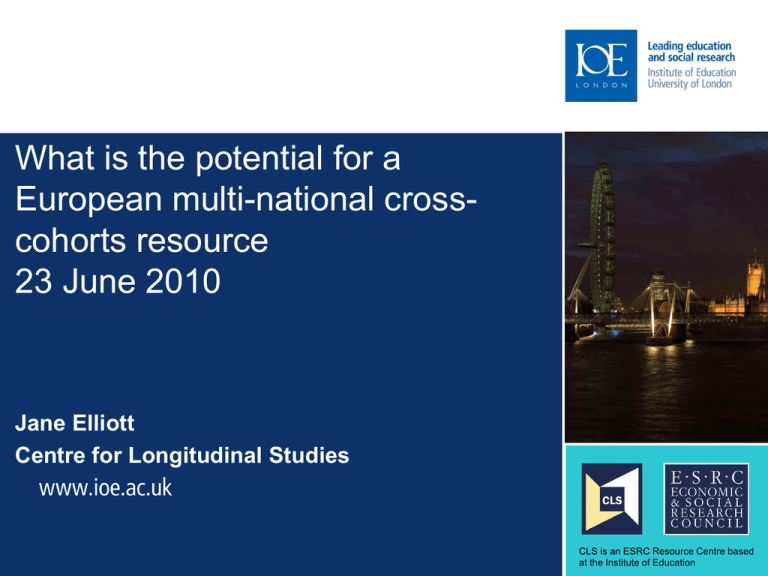
Sub-brand to go here What is the potential for a European multi-national crosscohorts resource 23 June 2010 Jane Elliott Centre for Longitudinal Studies CLS is an ESRC Resource Centre based at the Institute of Education Outline What cross-cohort analysis is already taking place? What are the existing infrastructures and networks? What are the different models for a multi-national cross cohorts resource? Questions for discussion Existing & potential cross-cohort analyses Comparison of cohorts born at different times in order to understand more about:a) Social Change b) Durability of individual responses under different conditions Comparison of cohorts born in different places - environment and health issues - labour market context - policy context - demographic context Pooling of data to increase power of analyses 3 British Birth Cohort Studies Fully representative samples of the British population Based on one week’s births - approximately 17,000 babies Followed up from birth into adulthood Four British Birth Cohort Studies • 1946 : National Survey of Health and Development (MRC funded) • 1958 : National Child Development Study • 1970 : British Cohort Study 1970 • 2000/1: Millennium Cohort Study 1958 & 1970 Birth Cohorts 60 Cohort Comparisons 50 46 42 Age 40 34 33 30 30 26 23 20 16 11 10 7 0 1950 0 1960 16 Life cycle effects 10 5 0 1970 1980 Year 1990 2000 2010 Source: Exploring Data (C. Marsh 1988) Figure 6.1 Unemployment as a problem in Britain: actual and perceived Source: unemployed claimant count: Employment Gazette Decembet 1982 and May 1986. Percentage naming unemployment as most or second most urgent problem facing the country: Gallup Political Index monthly. Proportion of women in paid employment, by age and cohort Source: Jenny Neuburger - Paper presented at CLS June 2008 Examples of research that has used British Birth Cohort data within the life course framework The consequences of parental divorce for children • ELY, M., RICHARDS, M.P.M., WADSWORTH, M.E.J. and ELLIOTT, B.J. (1999) Secular changes in the association of parental divorce and children’s educational attainment – evidence from three British birth cohorts. Journal of Social Policy, 28(3), 437-455 Changing levels of social mobility BLANDEN, J., GOODMAN, A., GREGG, P. and MACHIN, S. (2004) Changes in Intergenerational Mobility in Britain. In Corak, M (ed), Generational Income Mobility in North America and Europe. Cambridge: Cambridge University Press Changes in women’s employment following childbirth JOSHI, H . and HINDE, P.R.A. (1993) Employment after childbearing in post-war Britain: Cohortstudy evidence on contrasts within and across generations. European Sociological Review, 9(3), 203-227 Cohabiting, marriage and fertility STEELE, F., KALLIS, C., JOSHI, H. and GOLDSTEIN, H. (2007) Changes in the relationship between the outcomes of cohabiting partnerships and fertility among young British women: evidence from the 1958 and 1970 Birth Cohort Studies. CLS Working Paper 2007/4. London: Centre for Longitudinal Studies What are the existing infrastructures and networks? Two contrasting examples – Eucconet and HALCyon 9 The European Child Cohort Network (EUCCONET) European Science Foundation Funding:- 5 years, from May 2008 to April 2013 Objectives • identifying cohort expertise in Europe; • sharing knowledge and experience with a broad range of cohort experts, including from outside Europe, and establishing a forum for an easy accessible expertise on these issues in Europe; • offering opportunities to go deeper on the cross-country comparison by sharing tools and questionnaires. 10 Healthy Ageing Across the Life Course (HALCyon) HALCyon brings together an interdisciplinary group of scientists working on nine UK cohort studies to understand three aspects of healthy ageing: physical and cognitive capability; psychological and social wellbeing; and the underlying biology of ageing Eight work packages will investigate how factors like early development, lifetime health, personality and nutrition, and geographical movements influence the process of healthy ageing Funded under the New Dynamics of Ageing Programme – cross council Research Programme 11 Possible models for a multinational comparative cohort research resource (1)? Resource model: Documentation emphasising common questions and themes Data harmonisation Single portal for information on all European cohort studies Bibliography on existing cross-cohort research Capacity building in cross national work Descriptive materials and resources on historical/geographical/policy context Opportunities for PIs of cohorts to meet and exchange information Dedicated staff to facilitate the above and provide a resource to 12 others Possible models for a multinational comparative birth cohort research resource (2)? Science-led model: Funding specifically for cross-cohort research projects Documentation & data harmonisation arising from projects Website to showcase programme of work - links to cohort studies used - papers and working papers on funded projects 13 Possible models for a multinational comparative birth cohort research resource (3)? Data collection model: European Cohort Single centrally coordinated study Federated studies (with a common core?) Birth/pregnancy single cohort Two or three cohorts starting at different ages Science –led : specific hypotheses Resource – led: Multipurpose resource 14 Adding infrastructure to data? Scale of European cohort could add additional benefits/infrastructure Development of new data collection technologies CAPI testing Documenting and subseting data Collection of retrospective life history data Instrument specification Interviewer training and acreditation Safe settings/methodologies for links to administrative and register data Biological specimens – storage and retrieval 15 Cohorts and Panels? Cohort Individual focus: larger sample more focussed data collection Cradle to Grave: biomedical focus Initial recruitment & retention Triangulated data – teachers, medical examinations 16 Questions for discussion What are the scientific gains to be made from a multinational comparative birth cohort research resource? Should it focus exclusively on recent birth cohorts? How might such a resource be structured? What sort of resources are needed to create this? 17 Website www.cls.ioe.ac.uk Please register for regular updates NCDS Follow-ups and sources of information 1958-2010 Original sample: all living in GB born in one week in 1958 PMS NCDS1 NCDS2 NCDS3 NCDS4 NCDS5 NCDS6 (1958) Birth (1965) 7 (1969) 11 (1974) 16 (1981) 23 (1991) 33 (2000) 42 (2002-3) 44-45 (2004-5) 46 (2008-9) 50 17,733a 16,883 16,835 16,915 16,457 15,600 15,145 12,037 11,739 12,316 Mother Medical 17,415b — — Parents — Parents — Parents School — School — School Tests — Tests — Tests Medical — Medical — Medical Subject — Subject — Subject — Subject Census — Census 15,425 15,337 14,647 Biomedical NCDS7 NCDS8 Tests 12,537 — Subject — Subject — Subject Spouse/ Partner Biometric measures Motherc Blood samples Children Saliva sample 11,407 Notes a: Target sample - Excludes emigrants, refusals & deaths. Includes immigrants at NCDS1-3. b: Achieved sample - At least on survey instrument partially completed c: Mother - Could be Cohort Member or spouse/partner 11,419 9,349 — Subject — Subject Consents to linkage Biographical interview 9,534 9,793
